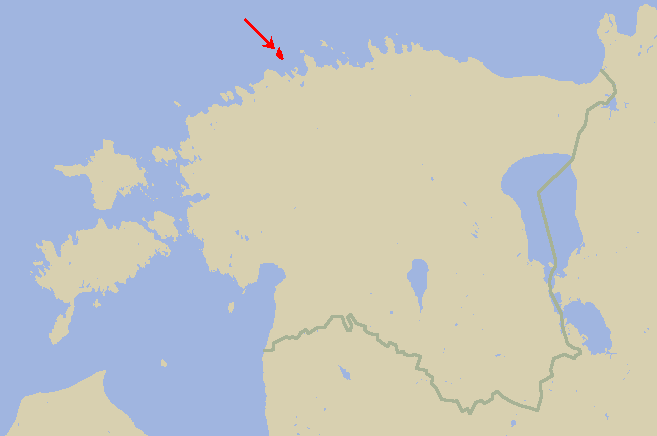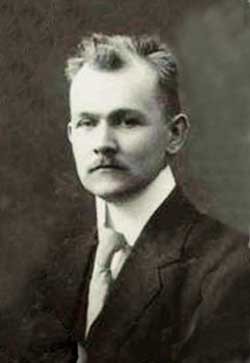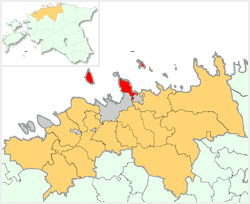|
Nargen
Naissaar ( sv, Nargö; german: Nargen) is an island in Estonia. It is situated in the Gulf of Finland, northwest of the capital city Tallinn, and is administratively part of the Viimsi parish. The island covers an area of . It is long and wide, and lies about from the mainland. The highest point on the island is Kunilamägi, which is above sea level. The island consists predominantly of coniferous forest and piles of stones and boulders. In 2020, the island had a population of 17; in 2011 the island had 35 or so permanent residents and some summer residents. Administratively the island is divided into three villages: Lõunaküla (Storbyn), Tagaküla (Bakbyn), and Väikeheinamaa (Lillängin). Until World War II, the island's native population numbered about 450 people of Estonian-Swedish origin. However, all of the local residents fled from Naissaar to escape the 1944 Soviet invasion of Estonia. During the 1944–1991 Soviet occupation the island was used by the military a ... [...More Info...] [...Related Items...] OR: [Wikipedia] [Google] [Baidu] |
Stepan Petrichenko
Stepan Maximovich Petrichenko (russian: link=no, Степа́н Макси́мович Петриче́нко; 1892 – June 2, 1947) was a Russian revolutionary, an anarcho-syndicalist politician, the head of the Soviet Republic of Soldiers and Fortress-Builders of Nargen and in 1921, ''de facto'' leader of the Kronstadt Commune, and the leader of the revolutionary committee which led the Kronstadt rebellion of 1921. Life Early years Stepan Maximovich Petrichenko was born in 1892 in the village of Nikitenka in the Zhizdrinsky Uyezd of Kaluga Governorate to a family of peasants. Two years after his birth, his family moved to Alexandrovsk (Yekaterinoslav Governorate), where Stepan graduated from city school and joined the local ironworks as a metalworker. In 1913 Petrichenko was called up for military service with the Russian navy, where he was assigned to the Russian battleship ''Petropavlovsk'', part of the Baltic Fleet. Soviet republic of sailors and builders Dur ... [...More Info...] [...Related Items...] OR: [Wikipedia] [Google] [Baidu] |
Russian Cutter Opyt (1806)
The Russian cutter ''Opyt'' (also ''Apith''; – Experience) was launched in 1806. The British 44-gun frigate captured ''Opyt'' in 1808 in the Baltic during the Anglo-Russian War (1807-1812) after her captain and crew put up a heroic resistance. The Admiralty took her into service as HMS ''Baltic''. She served briefly with the British fleet under Vice-Admiral Sir James Saumarez in the Baltic before being sold in 1810. Russian service ''Opyt'' was a purpose-built cutter that cruised in the Baltic in 1807. On 1808 she arrived at Sveaborg from Kronshtadt to join the division under Captain of 2nd rank Lodewijk van Heiden (who went on to become the Russian Admiral at the Battle of Navarino in 1827), to help in the city's defense. On ''Opyt'' put to sea in company with the sloop-of-war ''Charlotta'' to cruise between Sveaborg and Hanko. During this cruise the two vessels became separated. ''Opyt'' returned to Sveaborg and was sent to find ''Charlotta'', but before she could meet ... [...More Info...] [...Related Items...] OR: [Wikipedia] [Google] [Baidu] |
Bernhard Schmidt
Bernhard Woldemar Schmidt (, Naissaar, Nargen – 1 December 1935, Hamburg) was an Estonian optician. In 1930 he invented the Schmidt camera, Schmidt telescope which corrected for the optical errors of spherical aberration, coma, and astigmatism, making possible for the first time the construction of very large, wide-angled reflective cameras of short exposure time for astronomical research. Childhood Schmidt was the son of Carl Constantin and Marie Helene Christine ( Rosen) Schmidt. He was born and grew up on the island of Naissaar, Nargen (Naissaar), off the coast of Reval (Tallinn), Governorate of Estonia, Estonia, then part of the Russian Empire. The inhabitants of this island, mainly Estonian Swedes, generally spoke Swedish language, Swedish or Estonian language, Estonian, but the Schmidt family also spoke German language, German. Bernhard was the oldest of six children, three boys (one of whom died in infancy) and three girls. Naissaar was a small, rural island whose popu ... [...More Info...] [...Related Items...] OR: [Wikipedia] [Google] [Baidu] |
Naissaar Aerial
Naissaar ( sv, Nargö; german: Nargen) is an island in Estonia. It is situated in the Gulf of Finland, northwest of the capital city Tallinn, and is administratively part of the Viimsi parish. The island covers an area of . It is long and wide, and lies about from the mainland. The highest point on the island is Kunilamägi, which is above sea level. The island consists predominantly of coniferous forest and piles of stones and boulders. In 2020, the island had a population of 17; in 2011 the island had 35 or so permanent residents and some summer residents. Administratively the island is divided into three villages: Lõunaküla (Storbyn), Tagaküla (Bakbyn), and Väikeheinamaa (Lillängin). Until World War II, the island's native population numbered about 450 people of Estonian-Swedish origin. However, all of the local residents fled from Naissaar to escape the 1944 Soviet invasion of Estonia. During the 1944–1991 Soviet occupation the island was used by the military a ... [...More Info...] [...Related Items...] OR: [Wikipedia] [Google] [Baidu] |
Terra Feminarum
Terra feminarum ("''Women's Land''") is a name for an area in Medieval Northern Europe that appears in ''Gesta Hammaburgensis Ecclesiae Pontificum'' (Deeds of Bishops of the Hamburg Church) by Adam of Bremen 1075 AD. ''Terra Feminarum'' in ''Gesta'' "Woman Land", terra feminarum, appears four times in various chapters of ''Gesta Hammaburgensis Ecclesiae Pontificum'' (Deeds of Bishops of the Hamburg Church) by Adam of Bremen in 1075 AD. :''"In the meantime Swedes (Sueones), that had expelled their bishop, got a divine revenge. And at first King's son called Anund, whose father had sent him to enlarge his kingdom, after arriving to Woman Land (patriam feminarum), whom we consider to be Amazons, was killed along with his army from poison, that they had mixed to the spring water." (III 15)'' :''"After that come the Swedes (Sueones) that rule wide areas up until Woman Land (terram feminarum). Living east of these are said to be Wizzi, Mirri, Lamiy, Scuti and Turci up until the border o ... [...More Info...] [...Related Items...] OR: [Wikipedia] [Google] [Baidu] |
Naissaar2
Naissaar ( sv, Nargö; german: Nargen) is an island in Estonia. It is situated in the Gulf of Finland, northwest of the capital city Tallinn, and is administratively part of the Viimsi parish. The island covers an area of . It is long and wide, and lies about from the mainland. The highest point on the island is Kunilamägi, which is above sea level. The island consists predominantly of coniferous forest and piles of stones and boulders. In 2020, the island had a population of 17; in 2011 the island had 35 or so permanent residents and some summer residents. Administratively the island is divided into three villages: Lõunaküla (Storbyn), Tagaküla (Bakbyn), and Väikeheinamaa (Lillängin). Until World War II, the island's native population numbered about 450 people of Estonian-Swedish origin. However, all of the local residents fled from Naissaar to escape the 1944 Soviet invasion of Estonia. During the 1944–1991 Soviet occupation the island was used by the military a ... [...More Info...] [...Related Items...] OR: [Wikipedia] [Google] [Baidu] |
Adam Of Bremen
Adam of Bremen ( la, Adamus Bremensis; german: Adam von Bremen) (before 1050 – 12 October 1081/1085) was a German medieval chronicler. He lived and worked in the second half of the eleventh century. Adam is most famous for his chronicle ''Gesta Hammaburgensis ecclesiae pontificum'' (''Deeds of Bishops of the Hamburg Church''). He was "one of the foremost historians and early ethnographers of the medieval period". In his chronicle, he included a chapter mentioning the Norse outpost of Vinland, and was thus the first European to write about the New World. Life Little is known of his life other than hints from his own chronicles. He is believed to have come from Meissen, then its own margravate. The dates of his birth and death are uncertain, but he was probably born before 1050 and died on 12 October of an unknown year (possibly 1081, at the latest 1085). From his chronicles, it is apparent that he was familiar with a number of authors. The honorary name of ''Magister Adam'' sho ... [...More Info...] [...Related Items...] OR: [Wikipedia] [Google] [Baidu] |
Great Northern War
The Great Northern War (1700–1721) was a conflict in which a coalition led by the Tsardom of Russia successfully contested the supremacy of the Swedish Empire in Northern, Central and Eastern Europe. The initial leaders of the anti-Swedish alliance were Peter I of Russia, Frederick IV of Denmark–Norway and Augustus II the Strong of Saxony– Poland–Lithuania. Frederick IV and Augustus II were defeated by Sweden, under Charles XII, and forced out of the alliance in 1700 and 1706 respectively, but rejoined it in 1709 after the defeat of Charles XII at the Battle of Poltava. George I of Great Britain and the Electorate of Hanover joined the coalition in 1714 for Hanover and in 1717 for Britain, and Frederick William I of Brandenburg-Prussia joined it in 1715. Charles XII led the Swedish army. Swedish allies included Holstein-Gottorp, several Polish magnates under Stanislaus I Leszczyński (1704–1710) and Cossacks under the Ukrainian Hetman Ivan Mazepa (1708–17 ... [...More Info...] [...Related Items...] OR: [Wikipedia] [Google] [Baidu] |
Single-ship Action
A single-ship action is a naval engagement fought between two warships of opposing sides, excluding submarine engagements; called so because there is a single ship on each side. The following is a list of notable single-ship actions. Single-ship actions Anglo-Spanish War * 1579, March 1 – ''Golden Hind'' captures the Spanish galleon ''Nuestra Señora de la Concepción''. Golden Age of Piracy * 1720, October 20 – British sloop ''Snow-Tyger'' under Jonathan Barnet captures the pirate sloop ''William'' and its owner Calico Jack. War of the Austrian Succession * 1743, June 20 – captures the Spanish treasure galleon ''Nuestra Señora de la Covadonga'' * 1746, 21 January – captures the French privateer ''Marianne'' Seven Years War * 1761, 1 January – captures the French merchant frigate ''Bien Aimé''. American Revolutionary War * 1776, July 27 – and have an inconclusive engagement * 1777, 12 July – British merchantman ''Pole'' repulses the privateer ''Americ ... [...More Info...] [...Related Items...] OR: [Wikipedia] [Google] [Baidu] |
Eesti Naissaar
Estonia, formally the Republic of Estonia, is a country by the Baltic Sea in Northern Europe. It is bordered to the north by the Gulf of Finland across from Finland, to the west by the sea across from Sweden, to the south by Latvia, and to the east by Lake Peipus and Russia. The territory of Estonia consists of the mainland, the larger islands of Saaremaa and Hiiumaa, and over 2,200 other islands and islets on the eastern coast of the Baltic Sea, covering a total area of . The capital city Tallinn and Tartu are the two largest urban areas of the country. The Estonian language is the autochthonous and the official language of Estonia; it is the first language of the majority of its population, as well as the world's second most spoken Finnic language. The land of what is now modern Estonia has been inhabited by ''Homo sapiens'' since at least 9,000 BC. The medieval indigenous population of Estonia was one of the last " pagan" civilisations in Europe to adopt Christia ... [...More Info...] [...Related Items...] OR: [Wikipedia] [Google] [Baidu] |
Estonian Language
Estonian ( ) is a Finnic language, written in the Latin script. It is the official language of Estonia and one of the official languages of the European Union, spoken natively by about 1.1 million people; 922,000 people in Estonia and 160,000 outside Estonia. Classification Estonian belongs to the Finnic branch of the Uralic language family. The Finnic languages also include Finnish and a few minority languages spoken around the Baltic Sea and in northwestern Russia. Estonian is subclassified as a Southern Finnic language and it is the second-most-spoken language among all the Finnic languages. Alongside Finnish, Hungarian and Maltese, Estonian is one of the four official languages of the European Union that are not of an Indo-European origin. From the typological point of view, Estonian is a predominantly agglutinative language. The loss of word-final sounds is extensive, and this has made its inflectional morphology markedly more fusional, especially with respect to no ... [...More Info...] [...Related Items...] OR: [Wikipedia] [Google] [Baidu] |
February Revolution
The February Revolution ( rus, Февра́льская револю́ция, r=Fevral'skaya revolyutsiya, p=fʲɪvˈralʲskəjə rʲɪvɐˈlʲutsɨjə), known in Soviet historiography as the February Bourgeois Democratic Revolution and sometimes as the March Revolution, was the first of two revolutions which took place in Russia in 1917. The main events of the revolution took place in and near Petrograd (present-day Saint Petersburg), the then-capital of Russia, where long-standing discontent with the monarchy erupted into mass protests against food rationing on 23 February Old Style (8 March New Style). Revolutionary activity lasted about eight days, involving mass demonstrations and violent armed clashes with police and gendarmes, the last loyal forces of the Russian monarchy. On 27 February O.S. (12 March N.S.) the forces of the capital's garrison sided with the revolutionaries. Three days later Tsar Nicholas II abdicated, ending Romanov dynastic rule and the Russian Empi ... [...More Info...] [...Related Items...] OR: [Wikipedia] [Google] [Baidu] |






